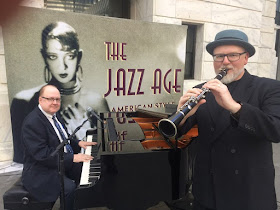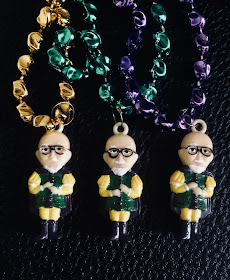Side 1
1. Licorice Stick (Fountain-Owen Bradley-Dant)
2. Young Maiden's Prayer (Fountain-Bradley-Dant)
3. Gravy Waltz
4. Fountain Blue
5. Tippin In
6. Estrellita
Side 2
1. Hello Dolly
2. Maria Elena
3. Clairnet Strip (Fountain-Bradley-Dant)
4. Born To Lose
5. The Honey Wind Blows
6. I Love You So Much It Hurts
Clarinet solo with Orchestra and Choir accompaniment
From the outset of this odd album we're greeted by a wordless chorus, banjo, and simplistic clarinet melody over 'rhythm changes.' It sounds a bit as though Ravel got lost in a department store in the Ozarks. For all it's odd simplicity, though, the tune is an historic one, at least in a crossover sense. Entitled 'Licorice Stick', it was co-written by Fountain, Owen Bradley, and Charles 'Bud' Dant. Jazz fans might not recognize the name of Owen Bradley (who shares composer credits with Fountain and Dant on three numbers), but to the history of Nashville, he is quite an important figure. His
Country Music Hall of Fame page credits him with shaping what became known as the "Nashville Sound" and even mentions Pete Fountain:
Owen Bradley was named head of Decca’s Nashville division in 1958, from which position he helped shape the evolution of the Nashville Sound. Like Chet Atkins, his counterpart at RCA, Bradley put singers out front, using rhythm sections consisting of guitars, bass, drums, and piano to provide basic support and adding background harmony parts or string sections as needed. The resulting music was easily accessible to a wide range of listeners. In addition to turning out hits by Decca’s country acts, Bradley also produced a Grammy-winning record for folk star Burl Ives (1962) and attracted Dixieland clarinetist Pete Fountain and pop organist Lenny Dee to Nashville. Bradley himself scored pop hits for Decca in 1957 (“White Silver Sands”) and 1958 (“Big Guitar”).
So far as I can tell, this album is the first of Pete's artistic efforts to combine New Orleans clarinet with the Nashville sound. Before purists get themselves into too much of a frenzy, and start shouting about 'commercialism' it's important to consider a couple of things. First, Pete never abandoned his hard earned jazz style, which was a combination of New Orleans, swing, and cooler west coast jazz. He continued to perform and record in that style for the rest of his days. Second, Pete's interest in the Nashville sound might not have been so completely mercenary as fans often assume. In his autobiography, he pointed out that his father was never much of a jazz fan--his dad actually preferred Country music. Discussing a later album, for instance, Pete tells this story:
Recently I have been recording in Nashville, where Owen Bradley has shown me some fantastic things about the business. There are more great musicians sitting around in the recording studios there than you can believe. They are loose.
My most recent album, New Orleans, Tennessee, was done there. It has a great country flair, really a swinging sound. Pop listened to it and said,"I'm glad you finally started to play some good music." He is still a staunch country-and-western fan. [pg 191]
It's in this spirit that we ought to listen to the Nashville efforts of Pete Fountain--not as a contribution to New Orleans style jazz, but as a new type of fusion. As such, they are at least unique, and as I have suggested before, seem a forerunner to Pat Metheny's Americana tinged guitar works.
'Young Maiden's Prayer' is another Fountain-Bradley-Dant collaboration, featuring Pete's full chalumeau singing a melody that hints at 'Amazing Grace', 'Deep River', and any number of other old spirituals. The backbeat is Nashville, with guitar giving country blues fills, and a twanged bass guitar that will be tough for some jazz fans to adjust to, but if accepted on its own terms is decent enough, if dated.
Ray Brown and Steve Allen's 'Gravy Waltz' is a return to the more easy listening jazz style Dant and Fountain cultivated on
I Love Paris a year before. The strings are less country, more Hollywood tinged.
Rod McKuen's 'Fountain Blue' is a pretty little ballad for Pete to play, with the Nashville sound (wordless female vocal, rhythm section, plinking piano) backing him up. Tunes like this are strong enough to warrant more performances, especially among clarinetists.
With 'Tippin' In' the album goes honky-tonk suddenly, and honestly, the record starts to seem a bit of a bizarre hodge-podge. 'Estrellita' rights the ship a bit, focusing once again on Pete's mellow chalumeau ballad capabilities.
One Side Two, Pete attempts to draft a bit off of Louis Armstrong's mega-hit 'Hello Dolly.' It would probably have benefited from a real jazz treatment with Pete's gigging band. This version comes off sounding too canned. There's a strange moment when a female voice says "Play it one more time"--the whole thing seems disembodied, as though the woman wasn't even in the same room as the band. It's a weird dissociated feeling one gets from some of this music, which I find paradoxically interesting but a bit creepy too--like hanging out in an abandoned shopping center after hours. This is even the zeitgeist for 'Maria Elena', a beautiful little melody Pete was to perform and record often. With 'Clarinet Strip,' we get some timbres that seem to have been sampled and used by They Might Be Giants thirty years later. To quote Johnny Carson, it's "weird, wild stuff."
This is a strange, sometimes awkward album for a jazz fan to listen to. I have no idea how it was received in 1964. It must have done well enough for Pete to make several more in the Nashville style. It's not my cup of tea...though I'll admit to a sort of strange attraction to figuring it out. To me it's like seeing your favorite Shakespearean in a really odd B movie. You can't help but watch it. Besides, as I wrote above, it really did aim at something unique--and at moments comes close to reaching something special. As a musician always looking for more creative projects and ways to reach out to new audiences, I think this album (and the Nashville projects which followed) are of definite value.
In the end, though, I think Pete will be best remembered for his New Orleans style work, and of albums that are like this one, I prefer 1962's
Swing Low, Sweet Clarinet, which already hinted at this direction.




















